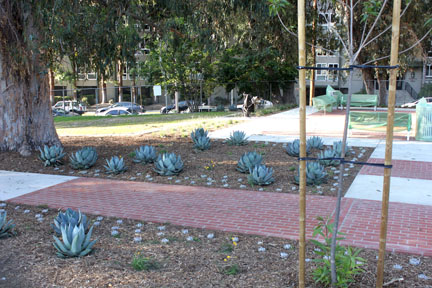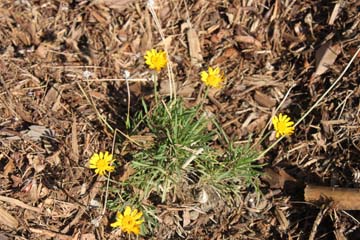Natives adorn landscape at Harold Henry Park renovation

AGAVE, Mexican snowball and angelita daisies adorn the brick pathway to the park’s reflective mid-section area under a ma-jestic eucalyptus tree.
Senecio, ceanothus, picture sage, Mexican snowballs, bladderpods, and yerba buena are just some of the drought-tolerant and California native plants that will be calling the renovated Harold A. Henry Park home and graciously adorning its freshly manicured grounds. Although the overall concept of the park, including its site configuration and spaces, remain the same, the biggest change to the park is in the plant materials.
New trees, such as corals, jacarandas, cercis, have also been planted. The park will feature a Smart Irrigation System, which takes site-specific attributes and conditions, registers them via satellite, and adjusts the system to only water what the plants need. Although the park features some native grasses, including deer grass and Pacific reed grass, they are mainly ornamental, particularly in the park’s reflective mid-section and pergola areas.
According to Craig Raines, the city’s Dept. of Recreation and Parks landscape architect responsible for the park’s new design, the changes at the park are “representative of a paradigm shift in the Department where they are moving away from traditional, European pastoral park designs to drought-tolerant landscaping that is more reflective of the landscapes in the Southwest.”
Therefore, the renovated park is representative of a trend in landscape design and could be a model for future projects.

DAISIES radiate warmth in the park’s new design.
The park renovation is a result of a successful public and municipal collaboration, which is reflected in the design. The inspiration for the park’s landscaping design came from the architecture and character of the surrounding neighborhood, Windsor Village. The park designers knew early on in the renovation that they did not want to change “the bones” of the park, and instead focused on elevating its design. The park’s original landscape design was based on standards from the 1960s, which did not focus on sustainability. The new design strongly focuses on sustainability.
One striking feature of the park’s landscaping is the dominant presence of new agave plants and their juxtaposition to more delicate, flowering plants, such as Douglas irises and angelita daisies. According to Raines, the preference for agaves stems from the fact that “from a design standpoint, agaves work well with many architectural styles and are native to Southern California.” In addition, “their color, texture, and form allow other plants to play off of them.” Overall, agaves have a very strong presence not shared by other plants. The intentional juxtaposition of the masterful agaves with the more delicate, colorful plants allows the plants to play off one another.
Raines hopes that park patrons will be inspired by the new design and compelled to plant drought-tolerant and California natives.
“People often associate California natives as ‘weedy,’ but with this park design, you can see that California natives provide subtle color and textural variations that is actually quite beautiful,” he added.
Grand re-opening ceremony for the newly renovated Harold Henry Park, 890 S. Lucerne Blvd., is set for Wed., June 3 at 8:45 a.m.
By Julie Stromberg
Guest writer
Category: Real Estate


